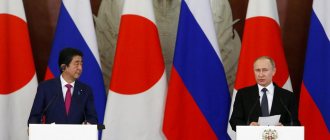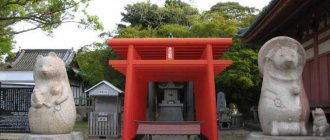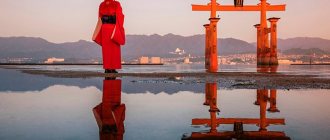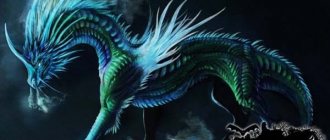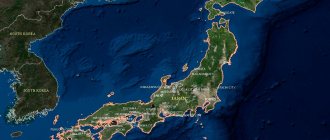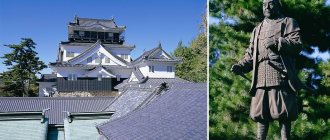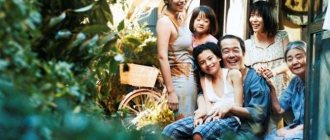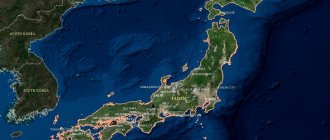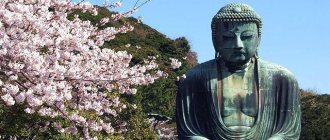The Japanese are an incredible and open-to-the-world people, whose character contains many distinctive features - hard work, discipline, practicality, accuracy. All this is intertwined with aesthetic features that are inherent in almost all Japanese, regardless of their location. After all, in addition to the 127 million local population , about 3 million more Japanese live in the largest countries of the world . The largest number of representatives of the Asian country live in the United States (1.2 million people), as well as in Brazil (about 1.5 million people). About 120 thousand Japanese live in Asia, approximately 90 thousand live in Canada. About 15 thousand people live in European countries. A small number of Japanese (5 thousand people) can be seen in Australia, as well as in other countries of the planet.
Japanese people
Cultural characteristics of the Japanese people
Japanese culture is extremely rich and diverse. The Japanese express a heightened feeling in almost all areas of life, including cultural traditions. Despite the fact that each region has some differences in this area, family traditions are sacredly respected here, and they attach great importance to national holidays and various rituals. One of the main distinguishing features of the Japanese is their elevated attitude towards the world around them. Only the subtle spiritual organization of the inhabitants can so poetically glorify the forces of nature in their creativity. The Japanese have no less scrupulous attitude towards flowers, which is expressed by the development of various styles of flower arrangements - ikebana, rikka, nageire, seike. The tea ceremony, founded by Sen no Rikyu, occupies a special place among the Japanese. To learn this difficult custom requires quite a long time and endurance, which the Japanese do not have to spare. An important feature of the ceremony is not only the process of drinking tea, but also the aesthetic pleasure that guests receive during the entire process. The ancient ritual takes place in specially designated rooms and represents one of the most important and meaningful national traditions.
How did the Japanese appear?
Having become acquainted with the history of the Japanese people, you immediately notice an amazing fact. Despite all the richness of its culture and historical path, Japan was not inhabited in prehistoric times, but relatively recently, in the 1st millennium BC. During this period, from ancient Chinese texts we learn that the Japanese (and they call them “Wa”) arrived on their islands from the Korean Peninsula.
By that time, the Japanese lands were already inhabited, but the aborigines had to make room. Many Ainu-Emisi tribes and southern Kumato and Hayaso communities retreated deeper into the islands and were later assimilated. The language of the new settlers was close to the Altai group.
Japanese family in a traditional Japanese house / © Cristian Negroni
The mixed culture became the basis for the emergence of a completely different people. In my opinion, we can confidently speak about the formation of the Japanese starting from the 1st-2nd centuries. Then the first Japanese state appeared - Yamato.
But there are many mysteries in the origin of the Japanese. The above version seems quite convincing, but quite recently scientists have proven that such a massive resettlement could not have happened in those distant times. If assimilation did not occur, then the Ainu and Austronesian tribes became the ancestors of modern Japanese.
Is it so? This topic can be debated endlessly, but it seems to me that the emerging culture of Japan was equally influenced by all the numerous nationalities that became the basis for the new tribe.
Japanese family practicing calligraphy / © Cristian Negroni
Japanese spirituality
The Japanese people's calm attitude towards religiosity is due to the formation of several spiritual directions over the years. But still, Buddhism and Sentoism have the main influence on the way of life of the population. A large number of temples, both ancient and modern, impress with their majesty and originality. Despite the technological progress that has engulfed one of the oldest countries on the planet, people here take the observance of local rituals quite seriously. In addition to visiting Buddhist and Sento shrines, a third of the population periodically makes pilgrimages, which has a positive effect on the level of spirituality of the Japanese.
Empire Paradise
Everything that will be discussed next is a completely new historical hypothesis. It is based on transcripts of the texts of the “Old Testament” - the oldest historical manuscripts in the world. These manuscripts, which Jews call the Torah, are approximately 4,500 years old. They are known to everyone and have a huge number of translations into all languages of the world. However, only very rare specialists know that these manuscripts contain information written in code or secret writing.
As a result of partial decoding of this information in 2007, I was able to discover that the cryptography contains historical material unknown to the scientific community. In particular, the secret writing says that after the creation of man by a higher mind and his reproduction, the world's first large empire called Paradise was formed.
The Empire of Rai was ruled by a family dynasty of pharaohs with the surname Ra (Solntsevs), which is why it was named after the surname of the pharaohs - Rai. The surnames of the daughter dynasties of the ruling family of the Solntsevs (Ra) were formed from the words of the “proto-language” and also contained the syllable Ra (Solntsevs) in their surnames. According to the order of formation, these are dynasties with surnames: Matara, Kara and Jara.
All the peoples of the Earth at that time spoke the same language, which I here call “proto-language.” Over the 4000 years of its existence, Paradise turned into a huge empire with borders from the Atlantic to the Pacific Ocean from west to east. The northern border of Paradise ran along the line: the Mediterranean Sea, the Black Sea, then along the mountain ranges of the Caucasus, Tibet, Karakorum, Tien Shan to modern Korea. From this border, the entire territory to the south belonged to the Rai Empire.
Because of the mistakes of scientists, we believe that Paradise is a kind of mythical garden of God, in which the first people originally lived. In fact, in the manuscripts of the Old Testament there is no word for Paradise at all, and the first people lived in a place called Eden in the texts. The name Paradise became mythical after the destruction of the empire and its entire history; it began to appear in manuscripts of translations of the Old Testament and other ancient historical literature, but no one knew the meaning of this word. They replaced the Old Testament concept of Eden, but such a replacement was unlawful.
According to the secret writing of the Old Testament, the Empire of Paradise occupied half of the entire landmass. The second half of the land was occupied by the empire of the Kara clan. In ancient documents, the empire of the kings from the Kara clan was called midnight, and the empire of Rai was called midday. By the time the Great Migration began, around 2000 BC, these two empires existed peacefully together, but under the primacy of the Empire of Paradise.
As a result of a geological cataclysm and global icing that occurred in the Kara Empire, the “Great Migration of Peoples” began, accompanied by large and long-term military clashes between the two empires. The Paradise Empire was completely destroyed by settlers from the Midnight Empire. Some of the royal families of Paradise were forced to flee to the outskirts of their empire. Among them are two large royal families of the Rai Empire with surnames: Matara and Taira.
Proto-language and surnames of the emperors of Japan
In a comparative analysis of the records of the “proto-language” found in the “Old Testament” and the ancient Japanese imperial families, it turned out that three surnames: Amatarasu, Taira and Fujiwara, are read in the “proto-language” in a completely unknown subtext in Japan. Two of them: Amatarasu and Taira, are the oldest imperial families of the Ra (Solntsev) family and are closely related to another ancient royal family, Jara.
The Jara dynasty of kings ruled in ancient times in India. This dynasty was the fourth in order of formation from the first royal dynasty of Ra. The second dynasty in the table of ranks of the Ra dynasties was the Matara dynasty, the third was the dynasty with the family surname Kara. It was from the surname Jara that the royal title of the rulers of India, Raja, arose from the rearrangement of syllables when reading the syllabic surname of Indian kings - Ja Ra (Ra Ja).
The royal families: Ra, Matara and Jara were in direct biological relationship and lived nearby. At the same time, the clan of Ra was the main one and ruled all the clans of Ra from the capital of the empire of Paradise, Babylon, whose ancient name was read as Babila. The kings of the Matara clan, I assume, ruled in the territory of modern Afghanistan. Linguistic studies of the “proto-language” show that the name of the Japanese Goddess Amatarasu is a late corruption of the surname of the Matara family. The surnames of later descendants of Matara were distorted in Japan in the form of the ending “Moto” instead of “Mata”.
For example, in the surnames Minamoto, Tsukamoto, etc. Even later descendants of the Ra family who were part of the Rai empire are the kings with the surname Taira. They ruled in ancient times the areas of modern China and Thailand.
It turns out that the basis of the clan imperial elite of ancient Japan were people from the regions of Afghanistan with the surname Matara (Amatarasu in Nihon Gaishi) and people from the region of modern China or Thailand with the surname Taira.
As a result of the “Great Migration,” under military pressure from the armies of ancient China, the Taira and Matara clans fled to the islands and there protected themselves from complete destruction.
Here is one very ancient tradition - read about real dzi beads - amulets made of stone, used in different beliefs and which can be found in both Tibet and Japan.
The Great Migration to the Japanese Islands
According to the secret writings of the Old Testament, approximately 2000 years BC. As a result of the “Great Migration,” the Paradise Empire was destroyed by settlers from the north. According to my research, one of the royal families of this empire, the Matara (Amatarasu) family, was expelled from its territory by the ancient Chinese Han family. Refugees from the royal house of Matara split into two groups: one fled to Egypt, the other towards the modern Japanese islands. Around the same time, the Chinese rulers of the Qin clan, with the support of the older clan of the Chinese Han rulers, seized the territory of the Taira clan for their settlements. The war for territory lasted for about a hundred years. Some of the descendants of the Taira imperial house also fled to the islands of Japan.
The descendants of the imperial house of Matara (Amatarasu), as a result of long wars with the Han dynasty (or as the Chinese write Han), were forced to flee their homeland, which, according to my information, was in the region of modern Afghanistan. Refugees go in two directions: west and east. A group of refugees moving east ends up on the islands of Japan, where they are accepted as relatives by the Taira clan that has already settled here. Another group of refugees reaches Egypt and is completely destroyed by the troops of the Khan (Han) clan.
The Matara clan, which settled on the islands of Japan, is older than the Taira clan; after some time, an internecine war for power arises between the descendants of these clans.
According to "Nihon Gaishi" we see only the last battles of the elder Matara family (Amatarasu) and its representative Minamoto (correctly read Minamata) in the struggle for power with the younger Taira imperial branch. As a result of this battle, the Taira clan is destroyed by the Minamata clan, belonging to a branch of the Amatarasu clan. This is what we see in the records of “Nihon Gaishi”
DISTORTION OF JAPAN'S FOREGOING LANGUAGE OVER 3000 YEARS
Historians believe that ancient Japan did not have a written language and the Japanese borrowed writing from the Chinese. New research shows that this assumption is wrong. The Japanese syllabary is, along with the ancient Egyptian syllabary, the most ancient language on the planet. It turns out that the ancient Japanese originally wrote in the “proto-language,” but, being under political and biological pressure from the Chinese empire for more than 3,000 years, they were forced to accept writing in Chinese characters.
However, the Japanese were not able to completely adapt their language to Chinese writing. As a result, two hieroglyphic syllabic alphabets arose in Japan: hiragana and katakana. Using “katakana,” the Japanese began to write down words for which there were no Chinese semantic characters [3, p. 515].
During the transition to Chinese writing, many ancient Japanese words were distorted and their exact meanings were lost. By comparing the “proto-language” found in the secret writings of the “Old Testament” and other manuscripts of the Jewish people, and a number of Japanese names and surnames, it was possible to restore their original meanings.
An ancient ruler from the Amatarasu (Matara) clan, known in the ancient history of Japan as Emperor Yamato, gave the name “Yamato” to the state on the islands with his family surname. This name lasted for a short historical period; in the “proto-language” it meant “Firstborn of the Mata clan” or “First of the Mata clan.” Later the country received the name Japan. This name is a distortion of the ancient syllabic phrase of the “proto-language” “Ia pan”. This is exactly how the name of the Japanese islands is written on the ancient maps of the Vatican.
In the "proto-language" this syllabic combination IA PAN is read as "Land (pan) of the firstborn (ia)." The fact is that the Matara (Amatarasu) dynasty, after the death of the main Ra (Solntsev) dynasty in Egypt, considered itself the first imperial dynasty on Earth. The syllabic combination Mata Ra is read in the “proto-language” as “Higher Sun”. Therefore, the name “Land of the First Born” or Iapan (Japan) reflects the position of the ancient family in the table of ranks of the Paradise Empire.
The fourth dynasty of the Rai-Jara empire, which ruled in India, retained its territories during the invasion of Chinese armies from the north by entering into inter-tribal marriages with the conquerors. The surname of the Jara or Raja dynasty is read in the “proto-language” as “Shining Sun”.
The Taira dynasty, which ended up as a result of flight to the islands of Japan, was the sixth dynasty in the table of ranks of the Rai Empire. The surname of the Taira dynasty in the “proto-language” is read as “Great Sun”. Thus, the image of the sun on the Japanese banner is a symbol of a dynastic family name, and not a geographical location or physical phenomenon, as is commonly believed.
New research shows that the title: “Emperor of China” was borrowed by Chinese settlers from the Taira clan, that is, from the ancestors of the Japanese.
Linguistic confirmation of the new hypothesis
A number of words and names preserved in Japanese culture support the hypothesis described here. Most of the meanings of ancient Japanese words are either unknown to the Japanese themselves or have been distorted over time. But they can be read using the “proto-language” discovered in the secret writings of the Old Testament. In particular, the name of the warrior of the imperial army “samurai” in the syllabary of the “proto-language” is read as “particle (sa) of the warriors (mu) of Paradise.”
The surname Fujiwara, in the syllabic version of Fu Ji Wa Ra, has its syllabic counterpart in the Indian language, where it is read as Jah Wa Ra and means “Thunderbolt”. In the “proto-language” this syllabic combination is read as follows: “Shining (Ja) in the water (Va) sun (Ra).” The meaning of the syllable "Fu" in the Fujiwara surname is not yet known. Vasily Melentyevich Mendrin believed that this syllable in ancient times meant “ruler” and was used in relation to the ruler of the ancient Japanese imperial army [1, p.112].
Then the entire Fujiwara surname should be read as "Ruler of Lightning Strikes" or "Ruler of Lightning." The ancient capital of Japan “Nara” in the syllabic “proto-language” is read as “the people of the Solntsevs”. The ancient military community of the Japanese was called Mura, which in the “proto-language” means: “Warriors of the Sun” or “Warriors of the Solntsev”. The Japanese word “kamikaze,” quite well known in the world, is read in the “proto-language” as “a killer whose death shines.”
The surname and name of the Japanese writer Rai Dze, who wrote down ancient Japanese legends, cannot be translated from Japanese into Russian. That is, in the Japanese language there is no understanding of what the ancient word Rai and the ancient word Dze mean. However, in the “proto-language” this name and surname have a very definite meaning. Paradise - belonging to the Solntsev family (Ra) Dze - shining.
All Japanese surnames ending in "moto" show their ancient kinship with the Matara dynasty. The fact is that the formation of royal or imperial families in ancient times had its own rules. The most distant relatives of the Matara surname could inherit only part of the surname, to which another word was added. This is how the surnames arose: Yamato (distortion of one letter from the Matara surname and cutting off part of the “ra”), Minamoto (distortion of two letters from the Matara surname and the addition of “min”).
In modern Japanese surnames these are already established distortions: Tsukamoto, Yamamoto, Matsumoto, Morimoto, etc. The origin of the syllabic combination “moto” has long been forgotten, but its modern translation is very close to the truth. The Japanese translate this word as "base". Indeed, the oldest surname in the world, Mata, which over time turned into “moto”, can be interpreted as “foundation” - basis, that is, the main one in the Empire. In the “proto-language” the syllabic combination Ma Ta is read as (Highest Mystery).
Let me remind you that the reading in the “proto-language” of all the mentioned dynasties of the Solntsev clan: Ra-Solntsevs (the pharaohs of the main clan dynasty, ruled in Babylon - the capital of the Paradise Empire); Ma Ta Ra - the Highest Secret of the Solntsevs (the surname of the kings of the second in origin of the Raya dynasty, who ruled the region of the Raya Empire, presumably in modern Afghanistan); Ka Ra - Killer of the Sun (the surname of the kings of the third dynasty of the Solntsev family, who ruled the midnight empire) Ja Ra - Shining Sun (the surname of the kings of the fourth dynasty of Paradise, who ruled in ancient India, the region of the Empire of Rai. Tai Ra - the Great Solntsev (the surname of the kings sixth in origin of the Raya dynasty, who ruled the region of the Raya Empire, presumably in the area of modern China and Thailand).
An inquisitive reader may ask. Why don’t the emperors of Japan bear ancient surnames, but many of them are found among ordinary Japanese? The fact is that there is another ancient tradition of the empire. This is a tradition of assigning lifetime and posthumous names to emperors. It is still unknown when it arose, but it was this tradition, as I assume, that broke the system of direct transmission of surnames in the ancestral house of the Japanese emperors. For example, the current Emperor Akahito will be called Emperor Heisei after his death. The tradition of assigning lifetime and posthumous names to emperors significantly confused the ancient history of this dynasty.
The same situation arose in ancient Rus'. Russian “Grand Dukes” and tsars, due to the tradition of calling them by their first names and nicknames, are still unknown by their last names. Let's take for example Yaroslav the Wise, Vsevolod Chermny and Ivan the Terrible. Due to falsification of chronicles in the 12th century, these people are considered to be the Rurik dynasty. In fact, by their real surnames they are Yaroslav Ivan, Vsevolod Volk, Ivan Monomakh.
Features of national character
In addition to their adherence to national customs and love of nature, the Japanese can safely be called workaholics. This wonderful people is distinguished by a special responsibility and sense of duty, characterizing each resident as an example of a disciplined and efficient worker. In everyday life, the Japanese are characterized by such traits as politeness, goodwill, and respect for the older generation. The upbringing of children has an important influence on family relationships, which consists of teaching them to observe subordination in relation to the older generation. In this way, a sense of community and valued interests develops. First of all, this concerns a certain group, which is a prerequisite for the development of such qualities as a sense of duty and devotion to authority. In the daily life of the Japanese, friendliness and friendliness are self-evident concepts. Starting from a salesperson in a store, who will show maximum courtesy in service, to an expensive restaurant, where any client will be served with a smile, not because of high tips, but because politeness is an everyday norm among the Japanese. An equally important trait of the average Japanese is curiosity, characterized by a certain direction. This is partly due to the influence of Buddhist culture on the thinking of the population, which is distinguished by certain specifics.
Activities of rulers
As I have already noted, the emergence of the Yamato state was an important event for the entire Japanese nation. It was this structure that set the tone for all subsequent state formations. The first imperial dynasty appeared in Yamato, the first ruler of which was Jimmu. It must be said that many historians consider Jimma only a character in legends.
Like many other peoples, the Japanese talked about a mythological ancestor who allegedly once ruled their lands and was famous for his courage and wisdom. However, the reality of Jimmu’s existence has not received any refutation.
“Jimmu-tenno toi seito”, 1891 Artist Ginko Adachi – stories from Nihon seki (Chronicles of Japan)
Throughout its history, Japan has experienced many changes of rulers and dynasties, wars and conflicts. Each period of its long journey was marked by the contribution of a certain emperor, who tried to strengthen or weaken the country (depending on his own interests).
In 1333, a war between the two dynasties results in the victory of Takauji, who subsequently founded the Southern Court. In the Northern Court during the same period, another ruler reigned.
Despite this, in fact, power was in the hands of military houses, and most of the wealth went to them. Of course, it couldn’t stay like this for long, and there were always those left out.
Traditional medieval Japanese army (Takeda clan), reenactment at the Yonezawa Festival / © Razvan by Getty Images
In 1467, a confrontation began, which led to the collapse of the Northern Court, but this did not contribute to the unification of the country. On the contrary, Japan entered a century-long period of fragmentation.
Local feudal lords also received support from arriving European travelers. The foreigners brought with them firearms (previously there were none in Japan) and a new religion. Christianity was perceived tolerantly by the Japanese - their beliefs allowed them to profess several religious directions, which was not considered a deviation from the faith.
Samurai battle, traditional Japanese drawing
Life, customs, culture[ | ]
Main article: Culture of Japan
The villages have a linear layout. A traditional house is a post-frame house, usually with 1-2 floors. Sliding walls made of frames covered with wax paper or cardboard are typical. The floor is raised on small stilts. It is almost completely covered with mats. Tables, chairs, armchairs are placed only in living rooms. The tables are low, the Japanese usually sit on their knees, on cushions. There are no beds, they sleep on a mat, and they put a board under their heads rather than a pillow. The house is necessarily decorated with original paintings, which may contain an image, a drawing, or an inscription (aphorism, quote). They are called kakemono.
Popular crafts include making dolls from wood or paper, weaving baskets, vases, and fans. Characterized by unique types of art: making paper figures (origami), arranging flower bouquets (ikebana).
In the visual arts, the Japanese have achieved great mastery in engraving (classical Japanese engraving).
The national clothing of the Japanese is called kimono (着物) - this is a general type of outerwear for men and women. The main nagagi kimono (長着) is put on the undershirt - juban (襦袢), adjusted according to height and secured with a narrow belt, on top of which a wide decorative obi belt is tied. White socks are put on the feet - tabi with a separate big toe. A summer casual kimono without lining is called a yukata. There are two types of shoes: zori (草履) (sandals made from straw, leather, rubber, etc.) and geta - shoes made of wood on two stands. Currently, the Japanese wear European clothes in everyday life. Kimonos can be seen on New Year's Day, coming of age, and at Japanese weddings.
Women's kimonos differ from men's in the cut of their sleeves. For women, the sleeves serve as pockets of sorts.
It is known that from ancient times the Japanese practiced a two-stage funeral ritual, and the first stage was the “Air Burial Rite.” This ritual was supplanted by the rituals of Buddhism[16][17].
How to identify a Chinese person
China occupies a leading position in terms of population. The giant country is home to up to 60 different peoples, which makes identification a little difficult. Plus, the Chinese are often keen on plastic surgery. Most often, the Chinese are confused with the Japanese. And this is the most offensive thing for them. So, how can you distinguish a true Chinese from a crowd of similar people?
Face
The faces of Chinese people have a round structure, the nose is moderately wide, this is especially noticeable on the wings. The lips do not stand out particularly, but the lower one is slightly fuller than the upper one. The forehead is quite wide, as are the cheekbones. The eyes are narrow. Single eyelids. The narrowness of the eyes is given by the arch of the eyebrow with a slightly raised outer tail.
Young Chinese. Photo: live-fts.flickr.com
Makeup
The Chinese have darker skin color than the Japanese and Koreans. Ladies use little decorative cosmetics, preferring natural beauty. Also, women from the Middle Kingdom do not like to sunbathe, but on the contrary, they try to whiten their faces with special means.
Body type
The Chinese are thin and of average height. Some believe that this happened because people did not eat enough meat. After all, both the Chinese and Japanese from time immemorial ate rice and seafood, and the introduction of meat products into their diet provoked an increase in average height by 10 cm.
The Chinese population is also distinguished by its slender legs. The last point applies to both men and women. It is worth noting that the mixing of cultures has led to more overweight people in China in the last couple of years.
The Chinese have heavier bones, so their gait is usually abrupt and rough.
Girls prefer natural beauty. Photo: commons.wikimedia.org
Behavior
The Chinese are distinguished by their slightly hot-tempered character, emotionality, and openness. They like to talk loudly both on the phone and during personal conversations. Often during an active discussion or statement they may spit on the ground.
The Chinese are not conservative, so they are not afraid of tactile contact even with a stranger.
Greeting style
The rules of etiquette among the Chinese are a little simpler than among representatives of other nationalities. As mentioned above, they enjoy talking to strangers. The Chinese can also easily pat you on the shoulder and exchange an active handshake. In rare cases, there may be a slight tilt of the head forward as a sign of greeting.
The older person always says hello first. Addressing “you” is allowed only among very familiar and close friends, so you can almost always hear a respectful “you” from a Chinese person.
Clothing style
The Chinese style of clothing is very diverse. The population, both young and old, is not afraid to experiment. Sometimes they combine outfits that are completely incompatible with each other in one image, and they can go to the store in pajamas. They also prefer layering and the use of the national Hanfu costume. This is how they express themselves.
Men love a sporty style, pairing jeans and sneakers, dress pants and a sweatshirt.
The Chinese are very noisy in society. Photo: pxhere.com
Language
Chinese is phonetically complex. The sounds are very slightly different from each other, but they mean different things. Speech is emotional, most often built on changes in tonality, changes in volume, and stress.
